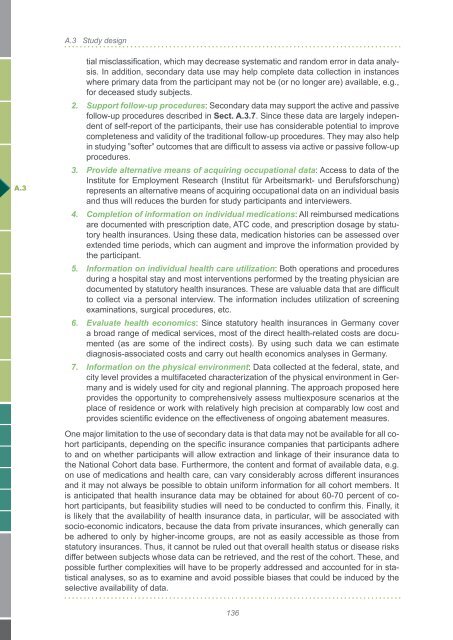Scientific Concept of the National Cohort (status ... - Nationale Kohorte
Scientific Concept of the National Cohort (status ... - Nationale Kohorte
Scientific Concept of the National Cohort (status ... - Nationale Kohorte
Create successful ePaper yourself
Turn your PDF publications into a flip-book with our unique Google optimized e-Paper software.
A.3<br />
A.3 Study design<br />
tial misclassification, which may decrease systematic and random error in data analysis.<br />
In addition, secondary data use may help complete data collection in instances<br />
where primary data from <strong>the</strong> participant may not be (or no longer are) available, e.g.,<br />
for deceased study subjects.<br />
2. Support follow-up procedures: Secondary data may support <strong>the</strong> active and passive<br />
follow-up procedures described in Sect. A.3.7. Since <strong>the</strong>se data are largely independent<br />
<strong>of</strong> self-report <strong>of</strong> <strong>the</strong> participants, <strong>the</strong>ir use has considerable potential to improve<br />
completeness and validity <strong>of</strong> <strong>the</strong> traditional follow-up procedures. They may also help<br />
in studying ”s<strong>of</strong>ter” outcomes that are difficult to assess via active or passive follow-up<br />
procedures.<br />
3. Provide alternative means <strong>of</strong> acquiring occupational data: Access to data <strong>of</strong> <strong>the</strong><br />
Institute for Employment Research (Institut für Arbeitsmarkt- und Berufsforschung)<br />
represents an alternative means <strong>of</strong> acquiring occupational data on an individual basis<br />
and thus will reduces <strong>the</strong> burden for study participants and interviewers.<br />
4. Completion <strong>of</strong> information on individual medications: All reimbursed medications<br />
are documented with prescription date, ATC code, and prescription dosage by statutory<br />
health insurances. Using <strong>the</strong>se data, medication histories can be assessed over<br />
extended time periods, which can augment and improve <strong>the</strong> information provided by<br />
<strong>the</strong> participant.<br />
5. Information on individual health care utilization: Both operations and procedures<br />
during a hospital stay and most interventions performed by <strong>the</strong> treating physician are<br />
documented by statutory health insurances. These are valuable data that are difficult<br />
to collect via a personal interview. The information includes utilization <strong>of</strong> screening<br />
examinations, surgical procedures, etc.<br />
6. Evaluate health economics: Since statutory health insurances in Germany cover<br />
a broad range <strong>of</strong> medical services, most <strong>of</strong> <strong>the</strong> direct health-related costs are documented<br />
(as are some <strong>of</strong> <strong>the</strong> indirect costs). By using such data we can estimate<br />
diagnosis-associated costs and carry out health economics analyses in Germany.<br />
7. Information on <strong>the</strong> physical environment: Data collected at <strong>the</strong> federal, state, and<br />
city level provides a multifaceted characterization <strong>of</strong> <strong>the</strong> physical environment in Germany<br />
and is widely used for city and regional planning. The approach proposed here<br />
provides <strong>the</strong> opportunity to comprehensively assess multiexposure scenarios at <strong>the</strong><br />
place <strong>of</strong> residence or work with relatively high precision at comparably low cost and<br />
provides scientific evidence on <strong>the</strong> effectiveness <strong>of</strong> ongoing abatement measures.<br />
One major limitation to <strong>the</strong> use <strong>of</strong> secondary data is that data may not be available for all cohort<br />
participants, depending on <strong>the</strong> specific insurance companies that participants adhere<br />
to and on whe<strong>the</strong>r participants will allow extraction and linkage <strong>of</strong> <strong>the</strong>ir insurance data to<br />
<strong>the</strong> <strong>National</strong> <strong>Cohort</strong> data base. Fur<strong>the</strong>rmore, <strong>the</strong> content and format <strong>of</strong> available data, e.g.<br />
on use <strong>of</strong> medications and health care, can vary considerably across different insurances<br />
and it may not always be possible to obtain uniform information for all cohort members. It<br />
is anticipated that health insurance data may be obtained for about 60-70 percent <strong>of</strong> cohort<br />
participants, but feasibility studies will need to be conducted to confirm this. Finally, it<br />
is likely that <strong>the</strong> availability <strong>of</strong> health insurance data, in particular, will be associated with<br />
socio-economic indicators, because <strong>the</strong> data from private insurances, which generally can<br />
be adhered to only by higher-income groups, are not as easily accessible as those from<br />
statutory insurances. Thus, it cannot be ruled out that overall health <strong>status</strong> or disease risks<br />
differ between subjects whose data can be retrieved, and <strong>the</strong> rest <strong>of</strong> <strong>the</strong> cohort. These, and<br />
possible fur<strong>the</strong>r complexities will have to be properly addressed and accounted for in statistical<br />
analyses, so as to examine and avoid possible biases that could be induced by <strong>the</strong><br />
selective availability <strong>of</strong> data.<br />
136



